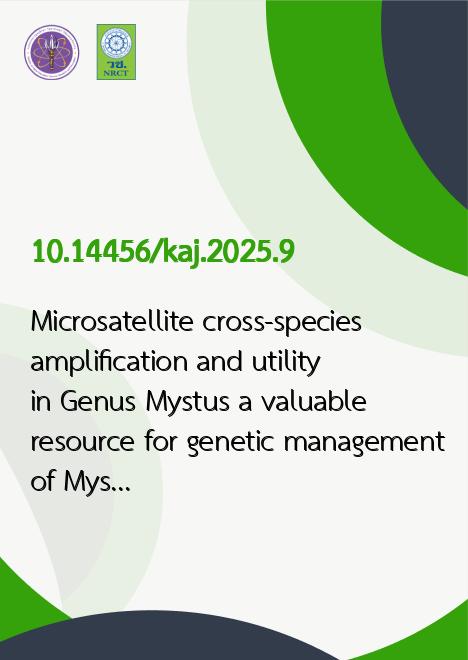
|
Microsatellite cross-species amplification and utility in Genus Mystus a valuable resource for genetic management of Mystus gulio |
|---|---|
| รหัสดีโอไอ | |
| Creator | Patchara Nithirojpakdee |
| Title | Microsatellite cross-species amplification and utility in Genus Mystus a valuable resource for genetic management of Mystus gulio |
| Contributor | Chaowalee Jaisuk, Khanoksinee Sirirak, Anocha Kiriyakit, Kitipong Suwannaket, Nipaporn Churaroum, Busaba Manosan, Jirarat Kantakoo |
| Publisher | Faculty of Agriculture |
| Publication Year | 2568 |
| Journal Title | Khon Kaen Agriculture Journal |
| Journal Vol. | 53 |
| Journal No. | 1 |
| Page no. | 109-120 |
| Keyword | Microsatellite, Genetic management, Mystus gulio, Long-whiskered catfish |
| URL Website | https://li01.tci-thaijo.org/index.php/agkasetkaj |
| Website title | Khon Kaen Agriculture Journal |
| ISSN | 3027-6497 (Online) |
| Abstract | Genetic population management in hatcheries is crucial for the success of aquaculture. Microsatellite markers are popular genetic markers used for studying genetic variation. However, the isolation of these markers requires prior knowledge of the genetic information of the target species, and the cost of developing microsatellite markers is expensive. Fortunately, microsatellite markers are often cross-transferable; markers developed for one species can be used in other closely related species. In this study, we tested for cross-amplification of microsatellite markers from published reports, initially developed for Mystus nemurus 11 loci, in Mystus gulio, which has been promoted for aquaculture. This study aims to gather genetic information for hatchery population management of hatchery in Chanthaburi Province. The cross-amplification of six loci was successful including MnRmCT6-2, MnRmE11-1, Mns432, MnBp8-1-30, MnVj2-1-62, and MnBp8-4-43b. Almost all microsatellite loci were found to deviate significantly from Hardy-Weinberg equilibrium except MnRmE11-1. The observed deviation shows that He > Ho, indicating that the sample has fewer heterozygotes than expected, and a positive FIS value suggests that the population has a low level of heterozygosity due to inbreeding. The evaluation of effective population size (Ne) in the sample group of M. gulio fish showed a Ne value that was too large to be accurately estimated (infinite), but evidence of a bottleneck was found. Therefore, the data from this study will be used to plan breeding programs to increase genetic diversity and reduce the risk of bottlenecks in sustainable M. gulio farming. |
